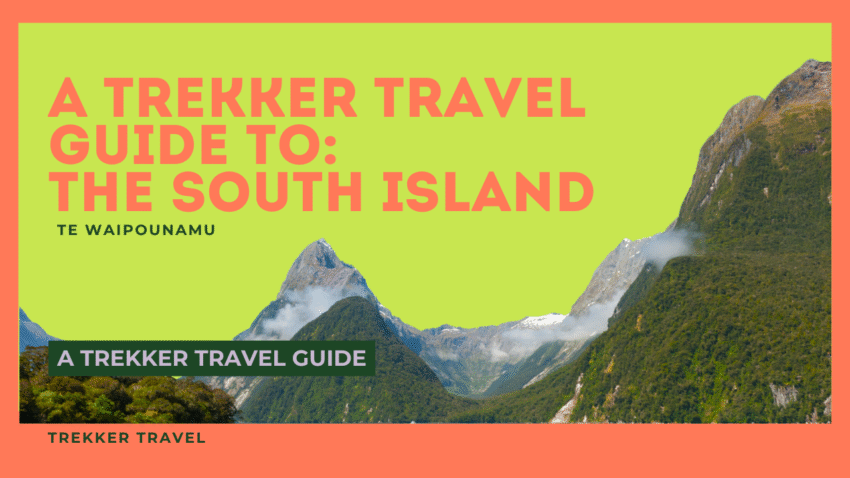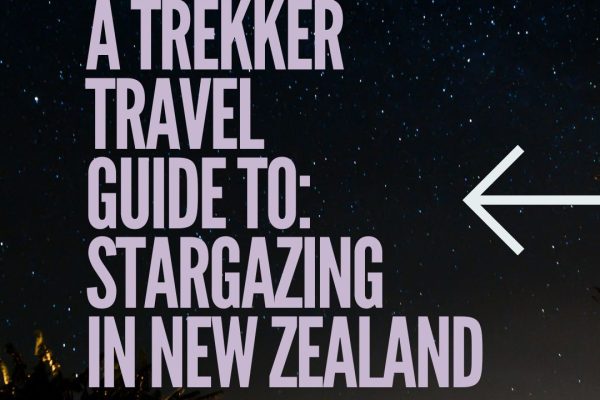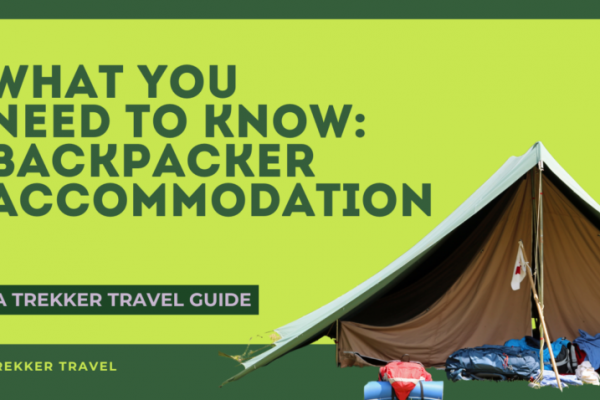A Trekker Travel Guide to The South Island, Te Waipounamu – New Zealand
Te Waipounamu, also known as the South Island translates to waters of greenstone, which is found in abundance throughout the Southern region.
In Māori mythology, the South Island is also known as Te Waka a Māui meaning the waka (canoe) that Māui and his brothers fished the North Island up from. It is a paradise for nature lovers, adventure seekers, and anyone looking to experience the unspoiled beauty of this incredible country.
From the majestic Southern Alps to the pristine fjords of Fiordland National Park, Te Waipounamu provides unlimited natural beauty.
Through this guide, we will explore each region and what you can expect to discover throughout them.
Marlborough – Te Tauihu-o-te-waka
Located on the northeastern tip of the South Island, the Marlborough region is known for its stunning natural beauty, rich history, and world-class wine.
Trekkers Must-See Marlborough:
The Queen Charlotte Track
Marlborough Sounds was originally a group of river valleys that were later naturally filled with the waters of the Pacific Ocean. Covered by steep hills that rise from the water and a multitude of bays, it is surrounded by incredible scenic walking tracks and hikes for varying levels of walkers.
One of Marlborough’s most well-known walks is The Queen Charlotte Track, an incredible 73.5 km coastal walk that is part of the Te Araroa Trail, it is shrouded in native punga and treetop canopies with views over Queen Charlotte Sound and Kenepura Sound.
Need to Know:
A pass is required for walking or biking the track between Kenepuru Saddle, Torea Saddle, Te Mahia Saddle, and Anakiwa. The fee for the pass helps with track maintenance and enhancements. You can purchase The Queen Charlotte Track Land Cooperative Pass from the Department of Conservation website.
Sea Kayaking Marlborough Sounds
Legend says, that the sounds were formed when Kupe the Māori navigator fought Te Wheke, a giant octopus. Their battle resulted in the bays and coves being gouged out creating the Sounds complex landforms that we see today. Guided tours are available to experience sea kayaking throughout the sounds, alternatively, you can rent a kayak and self-guide through the exquisite water pathways of this legend. You’ll have opportunities to see stingrays swimming alongside your kayak whilst you embrace the natural beauty of the sounds, and maybe even an Octopus on your journey. Taking this area by sea is unmissable.
Motuara Island Scenic Reserve
For nature lovers, the Motuara Island Scenic Reserve is not to be missed. Located at the base of the Queen Charlotte Sound opposite Ship Cove, The Island is home to some incredibly rare birds, including the yellow-crowned parakeet, the nocturnal Okarito brown kiwi and the South-Island Saddleback. You can reach the reserve by sea kayak or by catching a boat from Picton which departs daily and takes about an hour. On the journey, you may see seals, penguins and dolphins.
Need To Know:
Motuara Island Scenic Reserve is 100% predator-free, before going to the reserve you must make sure you do not have any pests in any of your clothing or gear.
Pelorus Bridge Swimming Spot
Located in the heart of Marlborough, the Pelorus Bridge Scenic Reserve is a stunning destination that offers breathtaking natural beauty and a range of outdoor activities. This picturesque reserve is nestled in lush native forest, surrounded by towering trees, crystal-clear streams, and scenic walking trails. The Pelorus River flows through the reserve, creating a beautiful swimming hole that’s perfect for cooling off in summer. The clear waters are surrounded by rocks and native vegetation.
The reserve offers several walking trails that cater to different fitness levels, from easy strolls to more challenging hikes. The trails take you through a variety of landscapes, including native forests, wetlands, and river flats, offering stunning views and opportunities to spot local wildlife.
The Pelorus Bridge Scenic Reserve is located approximately 45 minutes north of Havelock, near the town of Rai Valley. The reserve is easily accessible by car, and there are clear signs directing you to the reserve area.
Nelson and Tasman – Whakatū & Te Tai-o-Aorere
Located on the northern South Island, Nelson and Tasman are two neighbouring regions that offer a unique blend of natural beauty, art, culture, and outdoor adventure.
Trekkers Must-See Nelson Tasman:
Abel Tasman National Park
New Zealand’s smallest, but most popular national park, Able Tasman boasts pristine beaches, clear waters, and scenic hiking trails. It’s a paradise for outdoor enthusiasts, especially those who enjoy tramping, kayaking, and exploring the natural beauty of the region. Throughout Able Tasman National Park you will discover much to see and do. Don’t miss Toka Ngawhā – Split Apple Rock, located between Kaiteriteri and Marahau. Toka Ngawhā translates to ‘burst open rock’ and was named after Māori legend. Legend says, that the boulder was split in half when two gods were fighting to have it, they used their strength to split the rock in half giving it its name today.
Ngarua Caves
Ngarua Caves is an incredible limestone cave system that offers a glimpse into the region’s geological history. Situated near Takaka, the cave system is home to an amazing display of glow worms which illuminate the ceiling with an ethereal glow. The caves themselves are made up of an impressive array of limestone formations, including stalactites and stalagmites, which have taken millions of years to form.
You can sign up to see the caves on a guided tour that explains the history, and significance of the caves themselves.
Rawhiti Cave
Another top cave located local to Takaka is Rawhiti Cave. Rawhiti, meaning sunrise in Te Reo gives the cave its name due to a phenomenon called phytokarst, the stalactite rock formation orients towards sunlight coming from the cave entrance. The Rawhiti Cave Track is a 1-hour walking track that leads up to a viewing platform.
Need to know:
The walk up to the entrance is steep and may not be suitable for all visitors. You can find out more on the Department of Conservations Rawhiti Cave Track information page.
Te Puna o Riuwaka – Riuwaka Resurgence
Located near Motueka, the Riuwaka Resurgence is approximately a 20-minute drive from the township. The resurgence is the point where a significant portion of the Riuwaka River re-emerges from beneath the ground. From the entrance, the path is a 10-minute walk through lush native bushlands to the crystal clear waters.
Need to know:
The Te Puna o Riuwaka is a sacred place for Māori and is considered to have powerful healing properties. Eating and swimming at this location is not allowed.
Whiskey Falls
Situated in Nelson Lakes National Park, Whiskey Falls can be accessed on foot or by water taxi from St Arnaud Visitor Centre. The falls are accessed via the Lakeside walking track which takes roughly 3 hours to complete. The falls themselves are almost 40 metres tall and are surrounded by thick moss and ferns.
West Coast – Te Tai o Poutini
Home to the glaciers and mountains of Franz Josef and Fox, scenic coastlines and native forests, the West Coast of New Zealand is one of the most diverse regions to visit.
Trekkers Must-See West Coast:
The Twin Glaciers – Franz Josef and Fox
The West Coast Glaciers are an unmissable destination on New Zealand’s West Coast. Franz Josef or Kā Roimata o Hine Hukatere in the Southern Alps is a glacier with a glacial descent of 3000m to 500m above sea level. Covered in crevasses and ice caves and surrounded at its base by rainforest, the Franz Josef glacier itself and surrounding walking tracks are phenomenal, featuring some of the most spectacular scenery in New Zealand. Just six kilometres from the centre of the village, it has a plethora of places to stay, eat, drink and enjoy on a visit.
Fox Glacier or Te Moeka o Tuawe is the smaller but longer of the two glaciers. At over 13 km in length, it is fed by 4 surrounding alpine glaciers. Close by you will find, Lake Matherson which provides a mirror reflection of Mount Tasman and Aoraki – Mount Cook on clear days.
You can visit either glacier at any time of the year and do so either by walking using public tracks that bring you close to the terminal face, paid tours and via helicopter and flight experiences.
Ōpārara Arches
In Kahurangi National Park, you will find a subterranean system of limestone arches, caves and rivers surrounded by dense rainforest. The arches have been carved by the Ōpārara River over many years creating the largest natural rock arch in the southern hemisphere.
Hokitika Gorge
Due to a silt-like sediment in the water called glacial flour formed by glaciers grinding down the rocks, the water at Hokitika Gorge is an amazing blue-green turquoise colour. To view the gorge via the suspension bridge only, take the 10-minute Hokitika Gorge Bridge walk. For a more immersive track, the Hokitika Gorge walk is an easy 2.4 km walk that takes you along the bank of the Hokitika River, along the boardwalks, and to various lookout points.
Need to Know:
Hokitika Lower Suspension Bridge is currently under refurbishment, however, the Department of Conservation suspension bridge remains open.
Charleston Glow Worms Tour
The enormous Te Ananui Cave system located in Paparoa National Park is a sprawling cave system made up of amazing water-sculpted canyons. With one of the world’s most incredible glow worm displays within the caves and opportunities to view via raft, tube or walk this trip is an adventure you don’t want to miss out on when touring the West Coast!
To check out this awesome experience, head over to Underworld Adventures, you can find them here! – https://caverafting.com/gloworm-cave-tour/
Surfing
If you want to make the most of the Southern and Western swells that come from the South Pacific Ocean that make the West Coast an idyllic surf spot, then head over to Nine Mile or Carters Beach. If you’ve never surfed before, but want to give it a go, there are plenty of private lessons available on the West Coast.
Check out https://www.outtheback.nz/ for guided surf tours!
Canterbury – Waitaha
Known for its grassy plains, snowy mountains, and sprawling countryside, Canterbury’s diversity extends from hilly coastal towns to alpine heights, and Christchurch the South Island’s largest city.
Trekkers Must-See Canterbury:
Lake Tekapo and The Dark Sky Reserve
Part of the Aoraki Mackenzie International Dark Sky reserve, Takapō is one of the best spots to view the night sky. Here you will find, iconic kiwi landmarks, The Church of the Good Shepherd and fields of lupin flowers that flourish in November, both seen in images of New Zealand worldwide. For those who want to view the spectacular nightscape in this prime location, The Dark Sky project operated by Ngāi Tahu Tourism runs tours of the skies, including tours that combine storytelling, science and tātai aroraki – Māori astrology.
Kaikōura
The northernmost district within the Canterbury region, Kaikōura is a 2.5-hour drive from Christchurch along the east coast. Known for its amazing marine life, you will have opportunities to see whales, dolphins, seals and sea birds like the albatross. The rugged coastline is also home to an amazing range of hospitality spots that offer locally sourced seafood and dining experiences. Check out Nins Bin, a family-run business that has been a go-to spot for Kiwi’s since the 70s for sustainably caught crayfish and seafood, cooked in a roadside caravan on State Highway One, twenty minutes north of Kaikōura.
Hanmer
Known for its natural hot springs, Hanmer Springs Resort Town is an awesome location for adrenaline seekers. With access to bungee jumping, dirt biking tracks, jet boating, trekking and the Hanmer Springs Thermal Pools and Spa, it’s a must-stop destination on your journey down from Marlborough or up from Christchurch!
Castle Hill
Kura Tāwhiti – Castle Hill is a conservation area an hour and a half drive from Christchurch. The limestone tors and boulders clustered on the hill are a huge draw card for hikers, climbers and anyone who wants to enjoy time among the rolling landscapes that surround these staggering rock formations. It’s a great spot for a picnic or bouldering, depending on how adventurous you are feeling. Along the Great Alpine Highway surrounding Kura Tāwhiti is Lake Lyndon near Porters Pass and Lake Pearson which both make great stops before and after visiting Castle Hill.
Corsiar Bay
Along Governors Bay Road, just past the Lyttleton township in Christchurch’s Port Hills are a series of picturesque swimming bays. Corsiar Bay is an idyllic spot on a sunny day and has a diving platform out in the bay. The ground is finely ground up shells, not sand so bringing Jandals is a must.
Need to Know:
There is limited shade at this location, so making sure you bring sun lotion is important!
Otago – Ōtākou
Home to some of New Zealand’s best ski fields, biking tracks and adventure sports activities, Otago boasts a winter wonderland for half the year. For the remaining six months, it is rewarded with long summer days great for exploring the busy townships, trails, lakes and adrenaline activities throughout the region.
Trekkers Must-See Otago:
Ski Fields
Queenstown and Wānaka’s ski fields are a top destination for snow sports enthusiasts, offering an unparalleled experience that combines breathtaking mountain landscapes, world-class ski resorts, and diverse snow conditions. The region’s ski fields offer one of the longest seasons in the Southern Hemisphere with visitors flocking to world-renowned fields including, Treble Cone, Coronet Peak, Cardrona and The Remarkables.
Lake Wakatipu
Māori legend says, that the rising and falling of the tide or standing wave at Lake Wakatipu is the heartbeat of Matau, a taniwha (water spirit) who is said to be sleeping on the floor of the lake. The lake is within a glacier-carved trench and is surrounded by mountains and villages including Queenstown.
Roys Peak Track
Near Wānaka, Roy’s Peak Track is a challenging 15.9km walking track. A popular day hike, visitors are rewarded with epic views of Lake Wānaka and Mount Aspiring on this scenic hike. The summit lies at 1,258 metres and is a large elevation climb.
Need to Know:
In the winter season, you may need crampons and an ice axe to complete this hike. There is no drinking water on this trail so you need to be prepared. This hike crosses private land, you must always stay on the marked track.
Southland – Murihiku
Southland is a region that lies in the broader Te Wāhipounamu – South West of New Zealand. South West New Zealand is one the great natural areas of the world and is internationally recognised as a UNESCO World Heritage site, covering 10% of New Zealand’s landmass at 2.6 million hectares. Southland itself is home to some of New Zealand’s most dramatic and iconic wilderness.
Trekkers Must-See Southland:
Fiordland National Park and Piopiotahi Milford Sounds
Te Rua-o-te-Moko Fiordland is a National Park that has remained one of New Zealand’s most exceptional destinations. At 1.2 million hectares, the national park is full of multi-day hiking trails. It features three of New Zealand’s Great Walks, The Routeburn Track, Milford and Kepler which earns it, its name as one of the world’s best hiking locations. The landscape is rugged, legend says the Demigod Tuterakiwhanoa carved the landscape from formless rock.
The most recognised feature of the National Park is Milford Sounds. Milford Sounds is the wettest inhabited place in New Zealand and one of the wettest in the world. Seeing more than 182 days of rainfall a year, this consistent rainfall contributes to the spectacular power of the waterfalls throughout the sounds. Milford Sound was carved by the erosion of ancient glaciers making its dramatic scenery unforgettable.
Patea Doubtful Sounds
The deepest of New Zealand’s fiords at 421 metres, it has several jaw-dropping waterfalls throughout its three branched routes. Home to the Fiordland Crested Penguin and bottlenose dolphins, it’s a much-loved visit for wilderness seekers. Doubtful Sound is accessible to visitors by a tour departing from Manapouri.
Stewart Island – Rakiura
Stewart Island is an island located approximately 30 km off the Southern tip of New Zealand’s South Island. To reach the Island, you need to catch a ferry from Bluff which takes an hour or fly from Invercargill or Queenstown. The Island is home to a range of accommodations and hospitality options. Dark Sky Sanctuary accredited and classified Stewart Island as having outstanding sky quality, making it a top destination for star gazing. Outside of marvelling in Stewart Island’s exceptional nightscape, there is a range of walking tracks and activities including kayaking, biking, diving and fishing.
Te Waipounamu is inundated with experiences and adventures that everyone can enjoy and explore.
Remember, New Zealand is precious, and everyone who lives and travels here has a responsibility to look after it. The Tiaki Promise is a commitment to care for New Zealand, for now, and for future generations.
By following the Tiaki Promise, you are making a commitment to New Zealand. To act as a guardian, protecting and preserving our home.
Nau mai, haere mai ki Aotearoa. Welcome to New Zealand.






